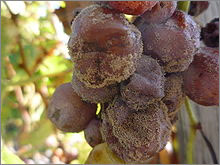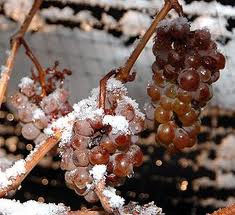Dessert wines are those sweet 'sticky' wines usually drunk with a meal, and are distinct from both white and red fortified wines which are drunk before and after a meal respectively. Many dessert wines gain their unique flavours from a fungus or grey rot that infects the grapes as they ripen, it is this rot that makes all the difference and adds so much extra character to the final wine.
Why rot is desirable for dessert wines

Botrytis cinerea on Semillon grapes in Sauternes
Wikipedia
The rot caused by a grey fungus called Botrytis cinerea infects the grapes, and should the weather conditions allow, and the natural sugars be high enough, the condition is termed "noble rot".
What happens is, in drier conditions and if the infected grapes are very ripe the fungus infestation will feed on these sugars producing unique concentrated flavours. However, should the weather be continually damp and wet, the fungus develops into the malevolent form called "grey rot" or "ignoble rot". This nasty version can wipe out grape crops completely.
When infested grapes are exposed to much drier conditions they can eventually turn into raisins, it is these grapes that are so highly prized by winemakers as the juice becomes so concentrated and luscious as the grapes dry out. The wine made from this nectar is the desirable botrytized dessert wine.
At harvest time on some wine estates, pickers will make several passes through the vineyard, picking the grapes berry by berry in order to capture the essence of every individual grape as it develops. This harvesting method cannot be mechanized and must be done by hand, so it is no wonder that most of the worlds top dessert wines command premium prices.
The difference between sweet wines and dessert wines
Just because a wine may be sweet does not necessarily make it a dessert wine. Dessert wines with their high concentration of natural sugar are higher in alcohol, whereas ordinary sweet wines are considerably thinner in body and have much lower alcohols. Sweet wines are often made by adding unfermented grape juice to a dry base wine, this is a technique developed in Germany many years ago.
The main factor about the high sweetness concentration in a dessert wine is that it is slightly viscous or sticky, in Australia these wines are known as 'stickies'.
EzineArticle Source: Dessert Wines and the Noble Rot Connection
By Rob Hemphill
Riedel Vinum Extreme Icewine/Dessert Wine Glass, Set of 2
Made in Bavaria by world-renowned glassmakers
Machine-blown lead crystal
Glass designed to highlight the fine qualities of dessert wines
8-7/8 inches tall; 10 ounce full capacity
Dessert wines pair perfectly with rich puddings.
A dessert wine is so called as it pairs so perfectly with so many rich puddings or desserts. It is important to remember that the wine must be sweeter than its complementary dish, otherwise the wine will taste sharp and acidic.
Where chocolate is involved, it is wise to match the lighter flavoured type of chocolate desserts with similar lighter bodied wines. Whereas, the bitter, stronger versions will go well with heavier, fuller bodied wines. A good example of a correct match is to pair a 'big' Zinfandel from California with a rich, bittersweet chocolate dessert. Make a good pairing and both the food and the wine will emphasise each other. Get it wrong - disaster!
When you have a dessert wine with the noble rot connection, you've found nectar befitting the gods. These gorgeous rich wines are so rare and special, that they should be sipped and not slurped, and savored with like-minded appreciative wine enthusiasts!
To learn more about wine, please visit Understanding Wine where you will find a wealth of interesting wine information.
Ice Wine (Eiswein) Is Pure Perfection

It seems odd to say that most of us don't often get to taste an ice wine. Why on earth don't we? Well, they are out there, and any worthwhile wine store will stock at least a couple of them. Although very expensive, a good ice wine is pure natural perfection - and worth every bit of the cost.
Should you ever be unable to find a gift for a friend, think about getting a bottle of this delightful liquid. Once you've tasted it - especially with something like a rich chocolate dessert - you will see what you have been missing out on. Yes, and by the way, chocolate does go with wine, but the wine has to be a rich 'sticky' one with buckets of sweetness.What is ice wine, icewine or eiswein?
It is a type of sweet or dessert wine that has been made from grapes that were allowed to freeze while still on the vine. One major difference between an ice wine and say a Sauternes or Tokaji, is that the grapes should not have been infected by the Botrytis cinera fungus or noble rot to any great degree.
As harvest time for ice wine is considerably later than that for a normal wine, it is vital that the grapes remain in a healthy state. Should any form of disease or fungal infection get onto them, they will deteriorate long before the harvesting period. This can be as late as January in the northern hemisphere.
Harvesting ice wine
The grapes, having been left on the vine, continue to gain natural sugars. As the autumnal weather arrives, the temperature slowly falls, but the acidity level remains fairly high which is important. If the acids dropped too quickly as the sugars rose, the resultant wine would have no character at all. The mark of an ice wine is that its high sweetness will be nicely balanced by a refreshing high acidity.
Harvest will take place when the grapes are actually frozen on the vine. It is a very time consuming process as picking has to be done by hand to enable accurate bunch selection. Pickers must often work unsociable hours to ensure that the grapes are not able to thaw out prior to pressing. Even the cellar staff will work in very cold temperatures.
How ice wine is made
The first problem to be faced is, 'how cold is too cold?' If the freeze is very severe, little or no juice will be extracted during pressing, so getting the harvest right is the key. When the frozen grapes arrive at the winery they will be pressed immediately, and as the sugars don't freeze and the water does, the extracted juice will be very concentrated and sweet. The downside of this is that there wont be much of it.
For the fermentation, special yeast strains will be used to cope with this high sugar level in the must. This will ensure that the ferment will be slower than usual and is a good thing, as the longer it takes, the more flavour is withheld and not ejected along with the carbon dioxide gas.
You can see how difficult it is producing ice wine, and the efforts involved in every stage of the process. It is no wonder that the end product is very expensive compared to ordinary wines. As the wines are so rich, they are nearly always sold in smaller bottles, from a half bottle size 375 ml down to some as small as the gift bottle size of 50 ml.
To me, the work that goes in to making ice Wine or eiswein is well worth it, ending up with a wine of sheer natural perfection. There are other ways to freeze grapes and make concentrated wines, but natures way is always the best.
If you've never tried and ice wine, go down to your local store, hunt one out, pair it with the right dessert, and most of all - savour the nectar!
By Rob Hemphill




